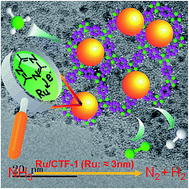Covalent triazine-based framework as an efficient catalyst support for ammonia decomposition
Abstract
The covalent triazine-based framework (CTF), a new type of nitrogen-containing microporous polymer, was employed as a catalyst support for ammonia decomposition. Either in terms of NH3 conversion rate or turnover frequency, Ru/CTF-1 has a highly enhanced performance compared to Ru/CNTs, which rank as one of the best un-promoted catalysts reported so far. The compositional and structural information of Ru/CTF-1 and Ru/CNTs catalysts have been characterized by ICP, N2 physisorption, XRD, TEM, XPS, and NH3-TPD techniques. Ru particles on CTF-1 and CNTs are ca. 3 nm in diameter and have a similar degree of dispersion. However, the binding energy of Ru 3p electrons is ca. 0.6 eV less for Ru/CTF-1 than that for Ru/CNTs showing significant increase in electron density in the former, which is likely due to the interaction between the nitrogen-rich groups of CTF-1 and the Ru nanoparticles. Moreover, the presence of CTF-1 enhances the chemisorption of NH3, which, together with the increased electron density of Ru, may facilitate the competitive chemisorption of NH3 and recombinative desorption of adsorbed nitrogen via lowered activation energy and thus, enable faster reaction rate.


 Please wait while we load your content...
Please wait while we load your content...